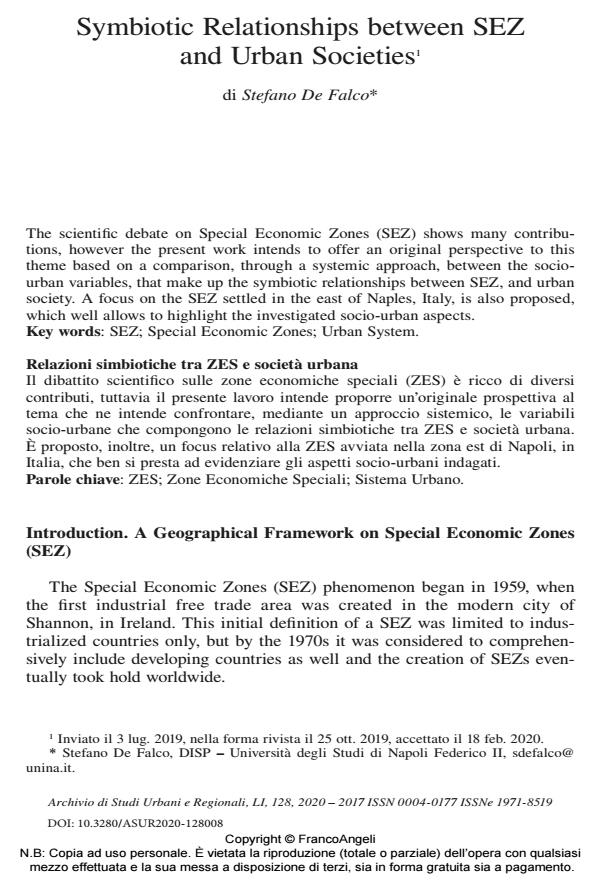Symbiotic Relationships between SEZ and Urban Societies
Titolo Rivista ARCHIVIO DI STUDI URBANI E REGIONALI
Autori/Curatori Stefano De Falco
Anno di pubblicazione 2020 Fascicolo 2020/128 Lingua Inglese
Numero pagine 20 P. 132-151 Dimensione file 212 KB
DOI 10.3280/ASUR2020-128008
Il DOI è il codice a barre della proprietà intellettuale: per saperne di più
clicca qui
Qui sotto puoi vedere in anteprima la prima pagina di questo articolo.
Se questo articolo ti interessa, lo puoi acquistare (e scaricare in formato pdf) seguendo le facili indicazioni per acquistare il download credit. Acquista Download Credits per scaricare questo Articolo in formato PDF

FrancoAngeli è membro della Publishers International Linking Association, Inc (PILA)associazione indipendente e non profit per facilitare (attraverso i servizi tecnologici implementati da CrossRef.org) l’accesso degli studiosi ai contenuti digitali nelle pubblicazioni professionali e scientifiche
The scientific debate on Special Economic Zones (SEZ) shows many contributions, however the present work intends to offer an original perspective to this theme based on a comparison, through a systemic approach, between the sociourban variables, that make up the symbiotic relationships between SEZ, and urban society. A focus on the SEZ settled in the east of Naples, Italy, is also proposed, which well allows to highlight the investigated socio-urban aspects.
Il dibattito scientifico sulle zone economiche speciali (ZES) è ricco di diversi contributi, tuttavia il presente lavoro intende proporre un’originale prospettiva al tema che ne intende confrontare, mediante un approccio sistemico, le variabili socio-urbane che compongono le relazioni simbiotiche tra ZES e società urbana. È proposto, inoltre, un focus relativo alla ZES avviata nella zona est di Napoli, in Italia, che ben si presta ad evidenziare gli aspetti socio-urbani indagati.
Keywords:ZES; Zone Economiche Speciali; Sistema Urbano.
- Addie J.P. (2017). From the urban university to universities in urban society. Regional Studies, 51(7): 1089-1099.
- Addie J-P., Angrisani M. and De Falco S. (2018). University-led innovation in and for peripheral urban areas: new approaches in Naples, Italy and Newark, NJ, US. European Planning Studies, 26(6): 1181-1201 Aggarwal A. (2012). Social and economic impact of SEZs in India. Oxford: Oxford University Press.
- Alfaro d’Alençon P., Campkin B., Gupte R., Mkhabela S., Novy J. and Savelad’Alen M. (2015) (eds.). Urban pamphleteer #5: Global education for urban futures. London: UCL Urban Lab.
- Alkon M. (2018). Do special economic zones induce developmental spillovers? Evidence from India’s states. World Development, 107: 396-409.
- Bender T. (1998). Scholarship, local life, and the necessity of worldliness. In: van der Wusten H., ed., The urban university and its identity: Roots, locations, roles. Norwell: Kluwer, 17-28.
- Benneworth P. (2013) (ed.). University engagement with socially excluded communities. London: Springer.
- Bräutigam D. and Tang X. (2011). African Shenzhen: China’s special economic zones in Africa. The Journal of Modern African Studies, 49(1): 27-54.
- Bräutigam D. and Tang X. (2014). Going global in groups: Structural transformation and China’s special economic zones overseas. World Development, 63: 78-91.
- De Falco S., Angelidou M. and Addie J.P.D. (2018). From the ‘Smart City’ to the ‘Smart Metropolis’? Building Resilience in the Urban Periphery. European Urban and Regional Studies, 7: 1-19.
- Dematteis G. (1980). La risposta dei geografi ai problemi di conoscenza posti dallo sviluppo della società italiana. In: Corna Pellegrini G. e Brusa C., a cura di, La ricerca geografica in Italia (1960 1980). Varese: ASK Edizioni, 483-489.
- Dematteis G. e Governa F. (2005) (a cura di). Territorialità, sviluppo locale, sostenibilità: il modello SloT, Milano: FrancoAngeli.
- Farole T. and Akinci G. (2011). Special economic zones: Progress, emerging challenges, and future directions. New York: World Bank Publications.
- Formato E. and Russo M. (2014). Re-use/re-cycle territories a retroactive conceptualisation for East Naples. Tema, Journal of Land Use, Mobility and Environment, 1: 432-440.
- Lipman P. (2011). The new political economy of urban education: Neoliberalism, race, and the right to the city. New York: Routledge.
- Lu Y., Wang J. and Zhu L. (2015). Do place-based policies work? Micro-level evidence from China’s economic zone program. -- Available on SSRN: https://papers.ssrn.com/sol3/papers.cfm?abstract_id=2635851.
- Moberg L. (2017). The political economy of special economic zones: Concentrating economic development. London-New York: Routledge.
- Pan W.H. and Ngo X.T. (2016). Endogenous growth theory and regional performance: The moderating effects of special economic zones. Communist and Post-Communist Studies, 49: 113-122.
- Pendras M. and Dierwechter Y. (2012). The problematic potential of universities to advance critical urban politics. Journal of Geography in Higher Education, 36: 307-321.
- Schmid C. (2014). Networks, borders, difference: Towards a theory of the urban.
- In: Brenner N., ed., Implosions/explosions: Towards a theory of planetary urbanization. Berlin: Jovis, 67-80. Sing M., Love P. and Liu H. (2018). Rehabilitation of existing building stock: A system dynamics model to support policy development. Cities, in press. SRM. -- Retrieved by www.sr-m.it/barometro-economia-zes/SRM.
- Sterman J.D. (2001). System dynamics modeling: Tools for learning in a complex world. California Management Review, 43(4): 8-25.
- Sterman J.D. (2010). Business dynamics: System thinking and modeling for a complex world. McGraw-Hill Education.
- Wang J. (2013). The economic impact of special economic zones: Evidence from Chinese municipalities. Journal of Development Economics, 101(1): 133-147.
- Zeng D.Z. (2011). How do special economic zones and industrial clusters drive China’s rapid development? -- Technical report available at: http://documents.worldbank.org/curated/en/310891468018256346/How-do-special-economiczones-and-industrial-clusters-drive-Chinas-rapid-development.
Stefano De Falco, Symbiotic Relationships between SEZ and Urban Societies in "ARCHIVIO DI STUDI URBANI E REGIONALI" 128/2020, pp 132-151, DOI: 10.3280/ASUR2020-128008